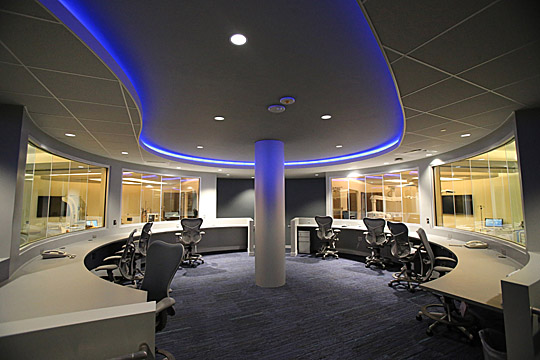On Tuesday, April 22 at 11 a.m., The University of Toledo will cut the ribbon on its three-story, 65,000-square-foot Interprofessional Immersive Simulation Center on UT’s Health Science Campus.
An open house for the UT community will be held Monday, April 21, from 7:30 a.m. to 6 p.m.
In this center, health-care professionals will learn to care for patients by practicing skills and procedures using simulation, as well as learn to work as teams in a virtual hospital equipped with human patient simulators. In addition, the center includes the introduction of 3D and Virtual Immersive Environments to medical education.

The Advanced Clinical Simulation Center on the second floor of the Interprofessional Immersive Simulation Center will include simulated hospital rooms, an intensive care unit, trauma suite, operating room, and labor and delivery room.
“Academic medical centers are expected to be on the leading edge when it comes to integrating technology into curriculum,” UT President Lloyd Jacobs said. “Graduates in medicine, nursing, pharmacy, therapy and the other health professions will be far ahead of their peers as they start to treat patients. The result will be fewer medical errors and better patient outcomes.”
While individual technological components of the UT facility may exist at other simulation centers, UT is among the first to bring together this range of simulation technologies in what Boyers calls the “tri-center concept.”
The Virtual Immersive Reality Center features the first five-sided, seamless, LED iSpace in the world, as well as a large, curved interactive and 3D wall and two smaller 3D walls — all offering virtual immersive experiences and an unlimited range of images. For example, in these virtual immersive environments, health-care students and other users will be able to “fly through” HD images of the human body from cells to organs, work on an oil rig, or design a new kind of automobile.
The Advanced Clinical Simulation Center on the second floor includes simulated hospital rooms, an intensive care unit, trauma suite, operating room, and a labor and delivery room, as well as pediatric and ambulatory rooms. Debriefing rooms are a feature of this simulation to encourage team problem solving and discussions to improve patient care.
The third floor’s Progressive Anatomy and Surgical Skills Center will feature several surgical skills suites with numerous stations and advanced procedural skills training labs.
In addition to supporting faculty and students at the University, the Interprofessional Immersive Simulation Center also works closely with several global industry collaborators, the U.S. military and other health-care organizations.
“Working collaboratively with experts in fields other than health care helps us broaden our knowledge and skills as we expand our capabilities. Our goal is to provide the best possible education and training so that patients are the beneficiaries of the safest, highest quality and cost-effective care,” Boyers said.